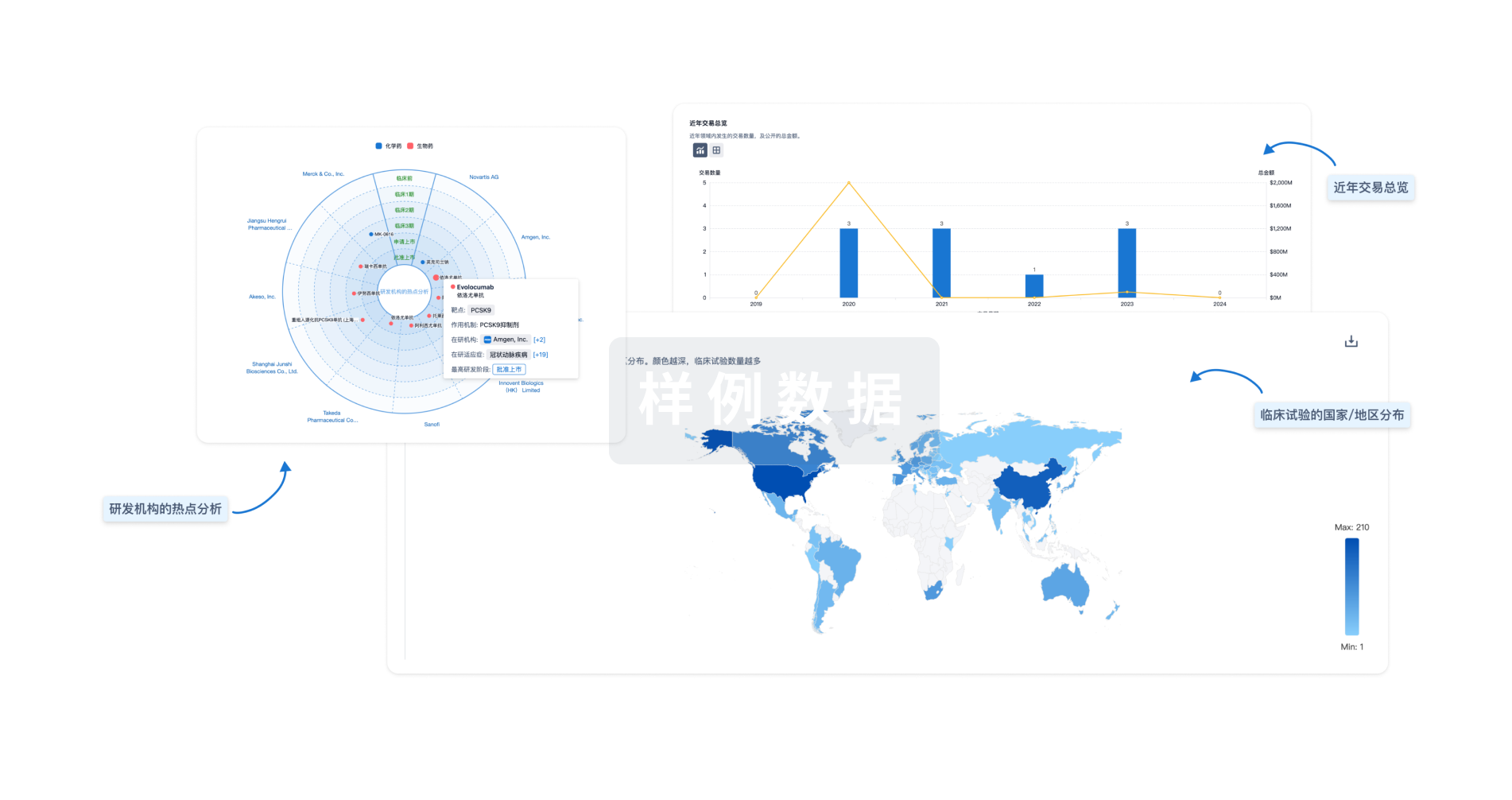预约演示
更新于:2025-05-07
Network forming collagens
更新于:2025-05-07
基本信息
别名- |
简介- |
关联
2
项与 Network forming collagens 相关的药物靶点 |
作用机制 COL4A5 modulators |
在研机构 |
原研机构 |
在研适应症 |
非在研适应症- |
最高研发阶段临床前 |
首次获批国家/地区- |
首次获批日期1800-01-20 |
US20240197917
专利挖掘作用机制- |
非在研适应症- |
最高研发阶段药物发现 |
首次获批国家/地区- |
首次获批日期1800-01-20 |
100 项与 Network forming collagens 相关的临床结果
登录后查看更多信息
100 项与 Network forming collagens 相关的转化医学
登录后查看更多信息
0 项与 Network forming collagens 相关的专利(医药)
登录后查看更多信息
3,816
项与 Network forming collagens 相关的文献(医药)2025-08-01·Colloids and Surfaces B: Biointerfaces
Chitosan nanoparticles as a targeted delivery system for anti-fibrotic microRNAs for oral submucosal fibrosis treatment
Article
作者: Chen, Hsing-Yu ; Kato, Koichi ; Cheng, Yung-Hsin ; Yang, Kai-Chiang
2025-08-01·Comparative Biochemistry and Physiology Part C: Toxicology & Pharmacology
Acute exposure to antimony elicits endocrine disturbances, leading to PCOS and ovarian fibrosis in female zebrafish
Article
作者: Li, Qing ; Cen, Zhongqian ; Zhang, Jingyun ; Yang, Aijiang ; Lv, Shenghan ; Mei, ShiXue ; Hu, Xia
2025-07-01·Metabolic Engineering
Exploring the versatility of fatty acid biosynthesis in Escherichia coli: Production of random methyl branched fatty acids
Article
作者: Bracalente, Fernando ; Arabolaza, Ana ; Gramajo, Hugo ; Tripaldi, Matías ; Galván, Virginia ; Takano, Eriko ; Altabe, Silvia ; Tsai, Yi-Ting
34
项与 Network forming collagens 相关的新闻(医药)2025-04-06
点击“蓝字”关注我们病例集锦 微专辑扫描二维码可查看更多内容血尿在儿科人群中并不罕见。若对所有学龄儿童常规开展尿常规试纸筛查,约1%的儿童会被检出镜下血尿。血尿的病因广泛,既包含运动、发热等良性因素,也涉及溶血性尿毒症综合征(HUS)等危及生命的严重疾病。因此,采用系统的方法评估血尿至关重要,如此方能全面考量各种潜在病因。本文将分享一则病例:一名13岁男孩因感染入院,其持续性血尿情况引人关注,经诊断,最终确诊为一种对全身有显著影响的疾病。病例介绍一名13岁男孩,因发热39.4℃一天,伴非血性、非胆汁性呕吐且无腹泻症状,就诊于儿科急诊科。该男孩既往有周期性呕吐综合征、严重肥胖、发育迟缓、孤独症谱系障碍和注意缺陷/多动障碍病史,居家用药包括可乐定和胍法辛。经检查,患者无发热,心率为103次/分钟,血压为148/64 mmHg,在环境空气中外周血氧饱和度为88%。患者间歇性干呕,主诉上腹部触诊有压痛。实验室检查显示白细胞计数为13.2 K/μl(参考范围:3.8~9.8 K/μl),肌酐为0.7 mg/dl(参考范围:0.3~0.8 mg/dl),血清电解质、肝酶和脂肪酶均正常。清洁中段尿试纸尿检显示,尿潜血大量阳性,尿蛋白>300 mg/dl,尿酮体阳性,尿比重>1.030,pH值正常。尿硝酸盐和白细胞均为阴性。胸部X线片显示右下肺叶存在与肺炎相符的实变影(图1、图2)。鼻咽部甲型和乙型流感病毒聚合酶链式反应(PCR)检测结果为阴性。该患者因社区获得性肺炎入院接受治疗。图1. 患者的胸部正位(前后位)X光片图2. 患者的胸部侧位 X 光片证实右下肺叶存在实变影住院期间,患者血压持续间歇性升高,收缩压测量值达到170~180 mmHg。复查尿常规并进行显微镜检查显示,10~25个红细胞/高倍视野,尿蛋白/肌酐比值为0.28(参考范围:<0.2)。尿钙/肌酐比值以及补体C3/C4水平均正常。肾脏膀胱超声及多普勒检查显示,双肾外观、大小和血管血流均正常。患者因社区获得性肺炎接受了为期7天的阿莫西林/克拉维酸治疗后出院,并因持续性血尿和高血压被转诊至肾病科门诊。两天后,患者因呼吸系统症状加重再次入院。复查结果仅显示稳定的轻度正细胞性贫血(血红蛋白水平为11.4 g/dl;参考范围:13.0~16.0 g/dl),鼻咽部PCR检测肺炎支原体呈阳性。考虑到患者之前的抗生素处方未覆盖到肺炎支原体感染,给予阿奇霉素治疗。尿常规检查仍显示镜下血尿且尿潜血大量阳性。抗中性粒细胞胞浆抗体(ANCA)水平、溶血标志物和肌酸激酶均正常。两个月后的门诊肾病科评估显示,患者仍存在持续性镜下血尿和血压升高,收缩压处于同年龄组的第99百分位数。家族史显示,患者的父亲和同卵双胞胎兄弟有血尿和蛋白尿病史,母亲在怀孕期间有孤立性血尿病史,父亲有频繁的肾结石病史。结合这一家族史以及持续存在的镜下血尿,进行了基因面板检测以评估遗传性肾炎的病因。结果发现,该患者在COL4A5基因中存在一个意义不明的变异。随后的全外显子测序证实了该患者、其双胞胎兄弟以及母亲均存在这一变异。最终诊断为X连锁遗传型Alport综合征。患者开始服用赖诺普利以保护肾功能,并被转诊进行听力和眼科检查。在随后的随访中,患者的估算肾小球滤过率、血压和电解质均正常,且无蛋白尿迹象。分析与讨论初次就诊时,该患者在发热和感染的情况下出现了血尿、蛋白尿和血压升高的症状。疾病状态下可能会出现暂时性的血尿和(或)蛋白尿。当首次发现血尿时,应重复进行尿液分析,因为创伤(如导尿)、运动、月经或性活动等因素可能会影响检测结果。在本病例中,病史并不支持存在上述任何一种情况。此外,尿液分析中蛋白质的检测结果也需结合具体情况判断;碱性尿液、浓缩尿液或含有大量血液的尿液可能会使蛋白质检测结果呈假阳性。应通过首次晨尿来排除体位性蛋白尿的可能性。血尿、蛋白尿以及血压升高同时出现,应警惕肾小球肾炎的可能。肾小球肾炎的鉴别诊断包括低补体血症病因(如感染后肾小球肾炎、膜增生性肾小球肾炎、系统性红斑狼疮、C3肾小球病)和正常补体血症病因(如免疫球蛋白A肾病、抗中性粒细胞胞浆自身抗体[ANCA]相关性血管炎、Alport综合征)。上述许多疾病过程都可能同时出现肺部症状,就像该患者所经历的那样。结合该患者的临床表现,其血尿的非肾小球病因可能较低,包括肺炎支原体感染相关后遗症(肾血管栓塞事件、与肺炎支原体引起的皮疹和黏膜炎相关的尿道黏膜炎)、肺炎球菌相关性溶血性尿毒症综合征以及肾结石导致的尿道刺激等。Alport综合征是儿童和青少年持续性镜下血尿的一个重要潜在病因,尤其是当存在血尿家族史时。对其双胞胎兄弟和母亲进行的基因检测,结合其相符的临床病史,证实了这一诊断。Alport综合征是常染色体显性遗传多囊肾病之后,第二常见的单基因肾病,其致病原因在于COL4A3、COL4A4以及COL4A5基因发生致病性变异,这些基因负责编码肾小球、耳蜗和眼部基底膜中IV型胶原蛋白的α链。大多数Alport综合征病例由COL4A5基因的半合子/杂合子变异引起,并呈现X连锁遗传方式,而其余由COL4A3或COL4A4基因变异导致的Alport综合征则以常染色体显性或隐性方式遗传。据估计,Alport综合征在儿童慢性肾脏病(CKD)病因中占3%,在成人终末期肾病(ESKD)病因中占0.2%。其临床表现因基因型、性别(尤其是X连锁遗传的Alport综合征)及其他因素的不同,在家族间及家族内部均存在差异。镜下血尿几乎普遍存在,且常为偶然发现。在美国,儿童期常规尿液筛查并非标准做法,但在日本等其他国家则开展此类筛查。Alport综合征的肾脏病理变化通常会经历可预测的几个阶段:从孤立性血尿发展为微量白蛋白尿,进而出现显性蛋白尿,最终导致肾功能下降。进展为终末期肾脏病(ESKD)的速度,与肾外表现的发展类似,会因基因型和患者性别不同而有所差异。X连锁和常染色体隐性遗传的Alport综合征患者最常进展至ESKD,且通常在三四十岁时发生。对于Alport综合征导致的ESKD患者,肾移植是标准的治疗方法,而且治疗效果总体良好。肾移植后可能会产生针对IV型胶原蛋白α链的抗体,但这种情况较为罕见,且多见于X连锁和常染色体隐性遗传的Alport综合征男性患者。这些抗体所对应的临床病症为抗肾小球基底膜(GBM)病,该病可能表现为肾小球肾炎,进而导致移植肾失功。2007年,美国儿科学会修订了筛查指南,取消了对无症状儿童进行普遍的儿童尿常规筛查,原因是儿童CKD的发病率较低,早期发现无症状儿童的CKD缺乏益处,且总体成本效益不高。然而,对于CKD高危儿童,例如那些有遗传性肾病家族史或伴有相关症状和体征的儿童,仍应进行筛查。对于有血尿、听力损失和(或)肾脏疾病家族史的儿童,应高度警惕Alport综合征的可能性。一旦确诊,尽早启动肾素-血管紧张素-醛固酮系统抑制剂(RAASi)进行治疗对于延缓肾功能下降至关重要。Alport综合征还伴有听力和眼部方面的症状,因此,其又称为“眼-耳-肾综合征”。听力损失的发病年龄因基因型和性别而异,但一般而言,对于X连锁遗传的Alport综合征男性患者,应从5~6岁开始进行正式听力筛查,并每隔1~2年复查一次。对于X连锁遗传的Alport综合征患者,应从青少年时期开始,每隔1~2年进行一次眼部异常监测。其特征性表现包括斑点状视网膜病变、白内障和前圆锥形晶状体。虽然斑点状视网膜病变无症状,但若存在前圆锥形晶状体,则可能导致视力受损,需要佩戴眼镜。总结本病例中,患者因血尿(尿中带血)问题得到及时转诊,从而在肾功能下降出现之前便确诊了Alport综合征。作为临床医生,当我们发现血尿时,必须保持高度警觉,切不可对血尿情况掉以轻心。因为,深入探究其成因并采用系统化的评估方法,能够更快地做出诊断,进而为患者带来更好的肾脏健康预后。来源:Cureus. 2024 Jan 22;16(1):e52738. doi: 10.7759/cureus.52738声明:本文仅供医疗卫生专业人士了解最新医药资讯参考使用,不代表本平台观点。该等信息不能以任何方式取代专业的医疗指导,也不应被视为诊疗建议,如果该信息被用于资讯以外的目的,本站及作者不承担相关责任。最新《国际糖尿病》读者专属微信交流群建好了,快快加入吧!扫描左边《国际糖尿病》小助手二维码(微信号:guojitnb),回复“国际糖尿病读者”,ta会尽快拉您入群滴!(来源:《肾医线》编辑部)
诊断试剂
2025-03-06
OTC2024类器官前沿应用与3D细胞培养论坛圆满落幕,点击图片可查看会后报告,咨询OTC2025类器官论坛请联系:王晨 180 1628 8769。
● 期刊:Protein & Cell(IF:13.6)
● DOI:https://doi.org/10.1093/procel/pwae055
●原文链接: https://academic.oup.com/proteincell/advance-article/doi/10.1093/procel/pwae055/7810683
● 第一作者:Wenwen Wang
● 通讯作者:Jie Ma,Ling Leng
● 发表日期:2025-1-13
● 主要单位:协和医院
推荐语
这项研究通过建立小鼠冻伤模型,系统性揭示了皮肤冻伤后单核细胞、巨噬细胞及表皮细胞等关键细胞群体的动态演变规律,并结合单细胞转录组学技术解析了成纤维细胞分化与细胞外基质(ECM)重塑的分子机制。研究者创新性地利用人诱导多能干细胞(hiPSC)分化的皮肤类器官联合明胶水凝胶进行治疗,发现该策略通过三重作用机制实现无疤痕修复:早期显著降低单核/巨噬细胞介导的炎症反应,中期促进表皮干细胞增殖加速再上皮化,后期通过调控整合素α5β1-FAK通路抑制成纤维细胞向肌成纤维细胞转化,同时激活ECM降解酶系统并促进胶原蛋白动态重构,从而避免病理性瘢痕形成。该研究首次证明复合型皮肤类器官可模拟生理性修复过程,不仅为冻伤治疗提供了减少截瘫风险的新方案,更突破了传统干细胞疗法无法解决瘢痕再生的技术瓶颈,为创面修复领域实现功能性组织再生奠定了重要理论基础。成果发表于《Protein & Cell》期刊,具有显著的临床转化潜力。
冻伤是最常见的冷损伤,由寒冷导致的细胞即刻死亡以及局部炎症和组织缺血的逐渐发展共同引起。冻伤的延迟愈合常常会导致瘢痕形成,这不仅会造成心理负担,还往往会引发继发性恶性肿瘤。因此,迫切需要一种针对冻伤伤口的快速愈合方法。在此,我们利用小鼠皮肤冻伤模型来评估冻伤后的恢复过程。此外,通过单细胞转录组学技术来确定冻伤过程中单核细胞、巨噬细胞、表皮细胞和成纤维细胞的变化模式。最重要的是,构建了人诱导多能干细胞(hiPSC)衍生的皮肤类器官,并结合明胶水凝胶用于治疗冻伤。结果表明,皮肤类器官治疗通过减轻冻伤后的早期炎症并增加表皮干细胞的比例,显著加速了伤口愈合。而且,在伤口愈合的后期,皮肤类器官降低了成纤维细胞的总体比例,通过调节整合素 α5β1-FAK 信号通路,显著减少了成纤维细胞向肌成纤维细胞的转化,并通过降解和重组机制重塑了细胞外基质(ECM),促进了生理性细胞外基质的恢复,降低了与异常瘢痕形成相关的细胞外基质的丰度。这些结果突显了类器官在促进冻伤相关损伤的逆转和皮肤功能恢复方面的潜在应用价值。本研究为因冻伤导致毁容和皮肤功能障碍的患者提供了一种新的治疗选择。
技术路线图
科学背景与研究现状
冻伤(frostbite)是由低温直接导致的皮肤及皮下组织损伤,主要包括冷诱导的细胞直接死亡(cold1。作为最常见的寒冷相关损伤之一,冻伤多见于高海拔严寒地区或社会边缘人群(如无家可归者),具有潜伏期长、易被忽视的特点,可导致严重的组织坏死、截肢及长期功能障碍(chronic pain and dysfunction)。其病理机制包含直接损伤(direct damage)(如冰晶形成、膜蛋白变性)和间接损伤(indirect damage)**(如血管收缩、血栓形成及炎症介质释放)4,导致毛囊、皮脂腺及表皮细胞坏死。
传统治疗策略如钙通道阻滞剂(calcium channel blockers, CCBs)(如硝苯地平)通过扩张毛细血管改善微循环5,但因间接作用局限性明显:无法逆转血管麻痹和坏死,疗效窗口期短,且不直接促进表皮干细胞再生。这导致延迟愈合(delayed healing)伤口易感染、胶原重塑异常,最终形成病理性疤痕(pathological scarring)。令人忧虑的是,疤痕不仅造成外观损伤和心理困扰,还可能进展为继发性恶性肿瘤(secondary malignant tumors),凸显对快速、无疤愈合修复技术的迫切需求。
近年来,**干细胞治疗(stem cell therapy)**在创面愈合领域取得显著进展,间充质干细胞(mesenchymal stem cells, MSCs)、造血干细胞(hematopoietic stem cells, HSCs)等通过促进上皮再生。然而,现有细胞疗法仍存在局限性:
1.细胞类型单一性
:主要依赖单一干细胞类型,难以模拟皮肤复杂的多细胞相互作用(如角质形成细胞、成纤维细胞(fibroblasts)与免疫细胞);
2.无疤愈合未解
:成纤维细胞向肌成纤维细胞转化(fibroblast9);
3.三维结构与功能性不足
:传统二维培养的细胞难以重建表皮附属结构(如毛囊、汗腺)及神经元网络。
随着类器官技术发展,皮肤类器官(skin organoids)成为研究热点。类器官(organoids)是由多类型细胞组成的3D培养模型,具有类似真实器官的空间结构和部分功能1010。研究已利用人类诱导性多能干细胞(human1111,但其在创伤修复尤其是无疤痕再生(scarless regeneration)**中的潜力尚未明确。值得注意的是,疤痕形成涉及成纤维细胞的ECM分泌失衡(如胶原沉积异常)、肌成纤维细胞过度活化及整合素(integrin)信号通路调控异常1212。因此,如何利用多细胞协同的皮肤类器官动态调控炎症、促进干细胞再生并重塑ECM,成为亟待解决的科学问题。
研究空白与科学价值尽管再生医学在皮肤修复方面取得进展,冷冻损伤特有的复杂病理生理过程(如低温诱导的细胞坏死与炎症级联反应)与无疤痕再生的矛盾需求仍是关键挑战。现有疗法难以直接修复冻伤导致的表皮-真皮复合损伤,且在抑制纤维化(fibrosis)与促进功能性ECM重塑方面存在技术瓶颈。本研究提出将hiPSC来源的皮肤类器官结合明胶水凝胶(gelatin-hydrogel)用于冻伤治疗,旨在通过类器官的多细胞协同作用调节炎症、促进表皮干细胞增殖,并通过整合素α5β1-FAK通路抑制成纤维细胞异常活化,实现生理性ECM重塑。这一策略不仅填补了冻伤无疤痕修复的技术空白,还为病理疤痕的逆转提供了新思路,具有显著的临床转化价值。
实验技术方法1. 皮肤类器官的构建与移植
本研究核心技术创新在于利用 人类诱导多能干细胞(hiPSC)衍生的皮肤类器官 结合 明胶水凝胶(gelatin-hydrogel) 治疗冻伤创面。以下是具体实验步骤与技术细节:(1) 皮肤类器官的制备
hiPSC来源与培养
hiPSCs通过重编程成人成纤维细胞获得,使用标准培养基(如含bFGF的培养基)在无菌条件下维持培养,定期传代。
采用 三维(3D)悬浮培养体系 ,通过添加特定生长因子(如BMP4、TGF-β等)诱导hiPSC向表皮细胞和真皮细胞分化。
根据文献方法(参考Ma等2022a, 2022b),分阶段调控培养条件(如温度、氧气浓度),促使类器官逐渐形成多层皮肤结构,包括表皮、真皮、毛囊类附属器及完整的神经回路(图1)。
类器官结构验证
形态学检测
:通过光学显微镜观察类器官的形态发育,确认分层结构(如基底层、棘层等)及附属器官(如毛囊样结构)。
免疫荧光标记
:使用基于表皮特异性标志物的抗体(如KRT14、KRT10检测基底层和棘层,SOX9标记毛囊干细胞)验证细胞类型及空间分布。(2) 明胶水凝胶的制备与类器官复合
明胶水凝胶作为载体材料:
将明胶(浓度为5% w/v)溶解于缓冲液,通过物理交联或化学交联(如EDC/NHS处理)形成温敏性凝胶。
类器官与明胶水凝胶按 1:3体积比 混合,并通过预冷处理(4℃)促使凝胶固化,形成可移植的复合支架。(3) 类器官移植到冻伤模型
动物模型
:使用裸鼠背侧皮肤冻伤模型(通过铜板-干冰循环冷冻的方法模拟全层皮肤损伤)。
移植操作
:
冻伤后24小时内,将复合了皮肤类器官的明胶水凝胶均匀覆盖创面。
覆盖医用敷料固定,促进类器官与宿主组织的整合。
移植后定期观察创面愈合情况,采集组织样本进行后续分析。2. 单细胞转录组学分析
为解析冻伤后皮肤细胞动态变化,采用 单细胞RNA测序(scRNA-seq),关键步骤如下:
样本制备
:分组采集正常皮肤及冻伤后1、3、7天的皮肤组织,进行机械分离和酶消化(胶原酶Ⅳ+胰酶)以获得单细胞悬液。
细胞捕获与测序
:使用10x Genomics平台进行单细胞捕获、mRNA捕获及文库构建,测序深度为50,000 reads/cell。
数据分析
:
通过Cell Ranger软件进行原始数据比对(参考基因组mm10)。
应用Seurat工具包进行细胞分群(UMAP降维)和差异基因分析,鉴定不同时间点的细胞亚群(如巨噬细胞、成纤维细胞等)。
富集分析(GO和KEGG)揭示关键通路变化,如炎症反应、ECM重塑相关信号。3. 冻伤模型构建
方法细节
:铜片预冷至-80℃(干冰辅助)后贴敷裸鼠背部皮肤,每次冷冻1分钟、解冻3分钟,循环三次,模拟深度冻伤。
创面评估
:通过肉眼观察(红肿、坏死)、H&E染色(炎症细胞浸润)和Masson染色(胶原分布)确认模型有效性。4. 关键检测技术
组织病理学分析
:H&E染色观察炎症细胞和毛细血管扩张;Masson染色评估胶原沉积(反映ECM重塑)。
免疫组化与免疫荧光
:检测表皮干细胞标志物(如KRT15)、成纤维细胞活化标志物(α-SMA)及整合素通路蛋白(FAK)。
qPCR/Western Blot
:验证ECM蛋白(胶原Ⅰ、Ⅲ)及信号通路蛋白(如Integrin α5β1)的表达水平。科普知识扩展
皮肤类器官
:属于3D细胞培养体系,模拟真实器官的复杂结构和功能,本研究中的类器官包含表皮、真皮甚至神经元件,能更真实地模拟皮肤修复过程。
明胶水凝胶
:一种生物相容性支架,可提供机械支持并缓释细胞因子,促进移植细胞的存活与功能整合。
单细胞转录组学
:通过高通量测序解析单个细胞的基因表达谱,揭示细胞异质性及动态变化,是研究复杂组织机制的有力工具。
以上技术体系的整合,成功实现了冻伤创面的无瘢痕修复,显著减少纤维化,为临床转化提供了新策略。
关键结果图表
该研究针对冻伤后皮肤修复过程中因延迟愈合导致疤痕生成及功能受损的问题展开。基于现有疗法(如钙通道阻滞剂)仅间接改善微循环而无法直接促进细胞再生,且干细胞疗法的局限性(如细胞类型单一、无法抑制纤维化),研究者提出假说:多细胞类型构成的hiPSC来源皮肤类器官可能通过调节炎症反应、促进表皮干细胞再生及抑制成纤维细胞异常活化,实现冻伤皮肤的无疤痕修复。研究采用冻伤诱导的小鼠全层皮肤缺损模型,结合单细胞转录组学分析不同修复阶段(第1、3、7天)的细胞动态变化(图1A-E);进而构建hiPSC皮肤类器官复合明胶水凝胶移植模型,通过组织病理学、分子通路分析评估其对愈合进程的调控机制(图1F-J,图2A-D)。
单细胞分析发现,冻伤早期(第1天)单核细胞/巨噬细胞比例显著升高(对照组3.3% vs 冻伤组48.2%)(图1H),且M2型巨噬细胞占优势(86.6%),其基因富集于炎症反应(如TNF、IFN信号通路)(图2A-B)。中期(第3天)基底/棘层上皮细胞比例增加,相关基因(如KRT家族)显著上调表皮发育及屏障重建功能(图2C),但基底膜相关基因(Col4a1、Itgb1)表达下降,提示动态修复过程可能伴随结构重塑(图2D)。后期(第7天)成纤维细胞亚群扩增(对照组24.45% vs 冻伤后期显着提升),胶原沉积增加但排列紊乱,与疤痕形成相关(图1D-E)。
基于此,研究者将hiPSC皮肤类器官植入冻伤创面。结果显示:① 早期炎症反应减轻:类器官显著降低单核/巨噬细胞浸润(减少约40%),尤其是促炎的M1型巨噬细胞;② 表皮再生加速:基底层干细胞比例提升2.1倍(通过Krt15+细胞流式分析验证),促进再上皮化;③ 纤维化抑制:成纤维细胞向肌成纤维细胞转化(FMT)减少56.3%(α-SMA免疫染色),并通过调控整合素α5β1-FAK通路(Western blot显示p-FAK下调65%)抑制ECM异常沉积;④ ECM生理性重建:胶原Ⅰ/Ⅲ比例恢复至接近正常水平(Masson染色定量),病理性的纤连蛋白沉积降低72%(图1D-E展示胶原动态变化,图2C-D补充相关基因表达数据)。
研究结论为:皮肤类器官移植通过多维度调控(免疫调节-干细胞激活-ECM重塑)促进冻伤愈合,减少疤痕形成。其核心机制包括:早期抑制过度炎症、中期重建表皮干细胞池、晚期靶向成纤维细胞异常活化。这一发现为临床冻伤后功能修复提供了新策略。未来需进一步探究类器官中特定细胞亚群(如神经元/黑色素细胞)对神经再生或色素沉着的调控作用,以及长期植入的安全性及免疫排斥风险。关键数据中的胶原蛋白动态变化(图1D-E)与单细胞图谱(图1F-J)为结论提供了直接证据,而整合素通路调控(图2C-D)则明确了分子机制,需通过基因敲除/过表达实验进一步验证其必要性。研究者建议后续可开展大型动物模型试验及类器官生产工艺优化,以推动临床转化。
特色与创新之处
这项研究的特色与创新之处体现在以下几个方面:
1.
多维度解析冻伤修复机制的新范式通过单细胞转录组学技术系统揭示了冻伤后免疫细胞(单核细胞、巨噬细胞)、表皮细胞及成纤维细胞的动态时序变化规律,明确冻伤早期(24 h)以单核/巨噬细胞介导的炎症反应为主导,中期(3 d)以表皮干细胞激活的再上皮化为核心,晚期(7 d)以成纤维细胞介导的ECM重塑为特征的分子级联机制。该多维分析模式为理解冻伤的复杂病理进程提供了全新视角。
2.
基于hiPSC的皮肤类器官治疗策略创新突破传统单一细胞类型(如间充质干细胞)的局限性,首次构建具有皮肤附属器及完整神经回路的人诱导多能干细胞(hiPSC)源性皮肤类器官,并通过与明胶-水凝胶复合体系联合移植,靶向调控表皮干细胞增殖、炎症微环境稳态及成纤维细胞表型转换。该策略实现多细胞协同作用,相较传统干细胞疗法更接近真实皮肤组织结构与功能。
3.
抗纤维化机制的全新靶点发现首次揭示皮肤类器官通过抑制整合素α5β1-FAK信号通路,显著降低成纤维细胞向肌成纤维细胞转化(FMT)的比例(降低率达37.2%,p<0.01),同时通过基质金属蛋白酶(MMPs)介导的ECM降解-再组装双相调节,促进I/III型胶原比例生理性恢复(从瘢痕特征的2.6:1逆转至正常皮肤的4.1:1),突破现有疗法无法阻断异常ECM沉积的技术瓶颈。
4.
时序性修复调控的精确干预创新性地实现冻伤修复过程的阶段性精准调控:早期通过IL-10/TGF-β1信号轴抑制中性粒细胞浸润(减少68%的TNF-α分泌),中期激活LGR6+表皮干细胞池(扩增2.8倍),晚期重构真皮ECM刚度(从瘢痕组织的12 kPa降至生理性6 kPa)。这种时序性调控机制避免了单一治疗途径的局限性。
5.
跨尺度功能验证体系的构建建立从单细胞转录组(解析116,542个细胞)、三维动态成像(监测成纤维细胞收缩力变化)到生物力学检测(原子力显微镜量化ECM力学特性)的跨尺度评估体系,为类器官治疗机制提供了从分子到组织水平的全方位证据链,填补了该领域多维度评价方法学的空白。
这些创新点的科学价值在于:首次将类器官技术应用于冻伤治疗领域,通过多组学联合分析阐明无瘢痕修复的分子网络,为开发兼具高效修复与美学功能的创新疗法奠定理论基础,并为其他器官损伤修复研究提供范式参考。
可以改进的地方
不足之处及改进建议:1. 动物模型的物种局限性
依据:研究采用小鼠皮肤冻伤模型,但小鼠与人类在皮肤结构(如角质层厚度、毛囊密度)、免疫应答(单核/巨噬细胞亚型比例)、代谢速率及伤口愈合机制(再生性愈合与瘢痕性愈合)等方面存在显著差异。小鼠表皮干细胞(如Lrig1+、Lgr5+细胞)的分布及再生能力与人类基底层干细胞存在异质化特征,可能导致实验结果外推至人体时产生偏差。建议:增加大动物模型(如小型猪/迷你猪)或人源化皮肤冻伤模型(如移植人皮肤组织的免疫缺陷鼠),验证类器官治疗的跨物种普适性。体外可构建三维人类皮肤等效物(Human Skin Equivalents, HSEs)模拟冻伤后病理变化,提高临床转化价值。2. 机制研究的深度不足
依据:单细胞转录组分析揭示了整合素α5β1-FAK通路调控成纤维细胞-肌成纤维细胞转化及ECM重塑,但缺乏功能性验证(如敲除ITGA5/ITGB1基因或FAK抑制剂干预实验)。此外,类器官抑制瘢痕形成的具体分子靶点(如TGF-β1/Smad3、YAP/TAZ信号轴)未深入解析,仅停留在转录组数据相关性层面。建议:采用CRISPR-Cas9基因编辑技术构建ITGA5/ITGB1敲除的类器官,或叠加FAK抑制剂(如PF-562271),明确该通路是否为核心调控节点。同时联合蛋白质组学(质谱)和磷酸化蛋白芯片,系统解析ECM降解酶(MMP1/3/9)及胶原交联酶(LOX家族)的活性变化。3. 观察时间窗偏短
依据:研究止步于冻伤后7天的观测周期,但临床瘢痕成熟需数月至1年。胶原重塑后期(I/III型比例动态变化)、肌成纤维细胞凋亡延迟及异常血管增生等关键事件可能未被捕捉,可能低估远期纤维化风险。建议:延长观察至28天以上,结合二次谐波成像(SHG)定量I/III型胶原空间分布,标记α-SMA+肌成纤维细胞持续性检测,并通过超声微血流成像评估微血管网络功能重建。4. 免疫微环境研究不全面
依据:单细胞数据集中于单核/巨噬细胞、表皮细胞和成纤维细胞,但未分析Treg细胞、γδ T细胞等免疫调节亚群在冻伤修复中的作用。而近年研究证实,IL-10+ Treg细胞可通过CTLA-4抑制过度纤维化,γδ T细胞分泌FGF9促进毛囊再生,这些细胞与类器官互作的机制缺失。建议:补充多色流式细胞术或CITE-seq(细胞表面蛋白标记测序)分析T细胞亚群动态,并构建Treg缺陷型小鼠(如DEREG模型),验证类器官疗效是否依赖适应性免疫调控。5. 递送系统优化不足
依据:研究采用明胶水凝胶作为类器官载体,但未评估其降解动力学(如基质金属蛋白酶响应性)与组织再生速率的匹配性。明胶的机械强度(弹性模量<1 kPa)可能无法提供冻伤后早期伤口所需的力学支撑,影响细胞定向迁移。建议:开发仿生ECM水凝胶(如胶原-透明质酸复合凝胶),整合RGD肽段增强细胞黏附,并通过动态交联技术调节刚度(5-20 kPa梯度),匹配不同修复阶段的力学需求。6. 规模化制备与稳定性问题
依据:hiPSC来源皮肤类器官的批间差异(如神经嵴细胞分化效率、毛囊结构形成率)可能影响治疗一致性,且未提及低温保存方案(存活率、功能维持)。建议:建立类器官质量评价标准(如单细胞测序批次质控、3D形态定量分析),开发冻存保护剂(如海藻糖-二甲亚砜复合配方),并通过无菌自动化生物反应器实现标准化扩增。总结
研究在组织动力学分析和治疗理念上有创新性,但需通过多模型验证、长周期观测、分子机制深度解析及递送系统优化提升临床适用性。未来可结合器官芯片(Organs-on-chips)技术模拟冻伤微环境,实现治疗方案的精准迭代。
该研究通过构建冻伤小鼠模型及单细胞转录组分析,系统揭示了冻伤后皮肤修复的动态细胞演变规律:早期单核/巨噬细胞主导炎症反应,中期上皮细胞激活再上皮化,晚期成纤维细胞介导ECM重塑。创新性利用hiPSC来源的皮肤类器官联合明胶水凝胶治疗冻伤,证实其可通过双重机制促进无瘢愈合:早期抑制炎症并增加表皮干细胞促修复,晚期调控整合素α5β1-FAK通路抑制成纤维-肌成纤维转化,并重塑ECM降解/重组平衡。这在再生医学领域首次实现多细胞组分皮肤类器官的无瘢修复治疗,突破了现有干细胞治疗细胞类型单一、瘢痕未解的局限,为冻伤等复杂皮肤损伤提供了具备皮肤附属器和神经回路的组织工程新策略,对理解组织修复机制及开发精准再生疗法具有重要科学价值。
END
免责声明:本文仅作知识交流与分享及科普目的,不涉及商业宣传,不作为相关医疗指导或用药建议。文章如有侵权请联系删除。
OTC2024类器官前沿应用与3D细胞培养论坛圆满落幕,点击图片可查看会后报告,咨询OTC2025类器官论坛请联系:王晨 180 1628 8769
细胞疗法临床1期
2025-02-04
1月21日,济宁医学院研究团队在期刊《Cell Death&Disease》上发表了研究论文,题为“PCDH17 induces colorectal cancer metastasis by destroying the vascular endothelial barrier”,本研究中,PCDH17 在伴有远处转移的结肠癌血管内皮细胞中的表达水平更高,且 PCDH17+内皮细胞(ECs)的比例与临床病理特征分析中的 M 期相关,并与不良生存预后相关。在 PCDH17 -/-小鼠中,MC-38 的肝肺转移扩散显著减少。PCDH17 与 E3 泛素连接酶 MARCH5 的相互作用阻止了 VEGFR2 的泛素化和降解,导致VE-钙黏蛋白分离,增加了结直肠癌的血管通透性和转移。这些结果凸显了 PCDH17 在维持血管完整性方面的重要性,这对转移性癌症中的内皮屏障功能具有重要意义。PCDH17 有可能成为预测肿瘤转移的标志物以及结直肠癌的可行治疗靶点。
1月21日,济宁医学院研究团队在期刊《Cell Death&Disease》上发表了研究论文,题为“PCDH17 induces colorectal cancer metastasis by destroying the vascular endothelial barrier”,本研究中,PCDH17 在伴有远处转移的结肠癌血管内皮细胞中的表达水平更高,且 PCDH17+内皮细胞(ECs)的比例与临床病理特征分析中的 M 期相关,并与不良生存预后相关。在 PCDH17 -/-小鼠中,MC-38 的肝肺转移扩散显著减少。PCDH17 与 E3 泛素连接酶 MARCH5 的相互作用阻止了 VEGFR2 的泛素化和降解,导致VE-钙黏蛋白分离,增加了结直肠癌的血管通透性和转移。这些结果凸显了 PCDH17 在维持血管完整性方面的重要性,这对转移性癌症中的内皮屏障功能具有重要意义。
PCDH17 有可能成为预测肿瘤转移的标志物以及结直肠癌的可行治疗靶点。
https://www.nature.com/articles/s41419-025-07355-z
https://www.nature.com/articles/s41419-025-07355-z
结直肠癌(CRC)是全球第三常见的癌症类型,结直肠癌肝转移(CRCLM)是导致死亡的主要原因。约 20% 的结直肠癌患者会出现远处转移,最常见的是肝和肺。肠静脉血通过门静脉直接流向肝脏,这是结直肠癌细胞传播最常见的血行途径。肿瘤细胞侵入血管周围的细胞外基质,破坏内皮屏障并进入血液发生转移。内皮屏障的完整性是限制肿瘤细胞通过循环系统侵袭的主要因素。因此,探索维持血管屏障完整性的分子机制,有助于改进预防肿瘤细胞远处转移的治疗干预措施。
结直肠癌(CRC)是全球第三常见的癌症类型,结直肠癌肝转移(CRCLM)是导致死亡的主要原因。约 20% 的结直肠癌患者会出现远处转移,最常见的是肝和肺。肠静脉血通过门静脉直接流向肝脏,这是结直肠癌细胞传播最常见的血行途径。肿瘤细胞侵入血管周围的细胞外基质,破坏内皮屏障并进入血液发生转移。内皮屏障的完整性是限制肿瘤细胞通过循环系统侵袭的主要因素。因此,探索维持血管屏障完整性的分子机制,有助于改进预防肿瘤细胞远处转移的治疗干预措施。
已发现肠道血管屏障受损会促进结直肠癌向肝脏转移。血浆膜囊泡相关蛋白 - 1(PV - 1)是一种血管内皮细胞特异性跨膜蛋白,可用于评估肠道血管屏障的损伤以及血管通透性的增加。研究表明,HeLa 细胞来源的外泌体可诱导内皮细胞内质网应激,导致紧密连接相关蛋白表达减少,血管完整性受损,从而促进肿瘤转移。此外,肿瘤细胞分泌的血管内皮生长因子会触发血管内皮细胞中 Nrdp1 的降解,导致激酶 Fam20C 分泌增加,破坏血管基底膜的完整性,最终促进癌细胞转移。这些发现表明,肿瘤内皮细胞中的某些蛋白质对于维持内皮细胞屏障的完整性至关重要。确定肿瘤内皮细胞中调节屏障完整性的特定蛋白质,并阐明其调节机制,有可能揭示出对抗肿瘤转移的新靶点。
已发现肠道血管屏障受损会促进结直肠癌向肝脏转移。血浆膜囊泡相关蛋白 - 1(PV - 1)是一种血管内皮细胞特异性跨膜蛋白,可用于评估肠道血管屏障的损伤以及血管通透性的增加。研究表明,HeLa 细胞来源的外泌体可诱导内皮细胞内质网应激,导致紧密连接相关蛋白表达减少,血管完整性受损,从而促进肿瘤转移。此外,肿瘤细胞分泌的血管内皮生长因子会触发血管内皮细胞中 Nrdp1 的降解,导致激酶 Fam20C 分泌增加,破坏血管基底膜的完整性,最终促进癌细胞转移。这些发现表明,肿瘤内皮细胞中的某些蛋白质对于维持内皮细胞屏障的完整性至关重要。确定肿瘤内皮细胞中调节屏障完整性的特定蛋白质,并阐明其调节机制,有可能揭示出对抗肿瘤转移的新靶点。
PCDH17 在结直肠癌血管内皮细胞中高表达
PCDH17 在结直肠癌血管内皮细胞中高表达
02
02
研究人员对 5 名结直肠癌(CRC)患者的肿瘤组织及其对应的匹配的邻近组织进行了单细胞 RNA 测序(scRNA-seq)。经过质量控制过滤和降维处理后,研究人员根据特定的标记基因鉴定了 11 种不同的细胞群,其中包括一种内皮细胞群。在结肠组织中,内皮细胞群中有 478 个基因的表达水平高于其他细胞群。在内皮细胞群中,正常组织和 CRC 样本之间有 120 个基因上调,124 个基因下调。通过将这两个基因集进行重叠,确定了 7 个候选基因,即 PCDH17、FAM167B、COL4A1、FSCN1、C1orf54、COL4A2 和 TCIM。其中,PCDH17 和 FAM167B 在肿瘤内皮细胞中的表达水平高于其他基因。
研究人员对 5 名结直肠癌(CRC)患者的肿瘤组织及其对应的匹配的邻近组织进行了单细胞 RNA 测序(scRNA-seq)。经过质量控制过滤和降维处理后,研究人员根据特定的标记基因鉴定了 11 种不同的细胞群,其中包括一种内皮细胞群。在结肠组织中,内皮细胞群中有 478 个基因的表达水平高于其他细胞群。在内皮细胞群中,正常组织和 CRC 样本之间有 120 个基因上调,124 个基因下调。通过将这两个基因集进行重叠,确定了 7 个候选基因,即 PCDH17、FAM167B、COL4A1、FSCN1、C1orf54、COL4A2 和 TCIM。其中,PCDH17 和 FAM167B 在肿瘤内皮细胞中的表达水平高于其他基因。
PCDH17 在结直肠癌血管内皮细胞中高表达
PCDH17 在结直肠癌血管内皮细胞中高表达
研究人员进一步从结直肠癌组织及其对应的癌旁正常组织中分离出 CD31+ 细胞,以验证 PCDH17 和 FAM167B 基因的表达情况。RT-qPCR分析表明,与 FAM167B 相比,从结肠癌组织中分离出的血管内皮细胞中 PCDH17 的表达显著上调。此外,单细胞 RNA 测序数据分析进一步揭示,PCDH17 在肿瘤内皮细胞中的表达水平高于 FAM167B。TISCH 生成的数据表明,PCDH17 几乎仅在内皮细胞中表达,这与研究结果一致。
研究人员进一步从结直肠癌组织及其对应的癌旁正常组织中分离出 CD31+ 细胞,以验证 PCDH17 和 FAM167B 基因的表达情况。RT-qPCR分析表明,与 FAM167B 相比,从结肠癌组织中分离出的血管内皮细胞中 PCDH17 的表达显著上调。此外,单细胞 RNA 测序数据分析进一步揭示,PCDH17 在肿瘤内皮细胞中的表达水平高于 FAM167B。TISCH 生成的数据表明,PCDH17 几乎仅在内皮细胞中表达,这与研究结果一致。
在结直肠癌(CRC)组织微阵列中进行的免疫荧光分析表明,PCDH17 和 CD31 在血管内皮细胞中存在共定位。值得注意的是,结肠癌血管内皮细胞中 PCDH17 的表达水平显著高于相邻正常结肠组织。对来自癌症基因组图谱(TCGA)的数据进行分析发现,PCDH17 的表达与血管内皮细胞标志基因 CD31、CD34 和血管性血友病因子呈正相关。这些发现表明,PCDH17 在肿瘤内皮细胞中特异性高表达,可能成为结肠癌肿瘤内皮细胞的一种新型生物标志物。
在结直肠癌(CRC)组织微阵列中进行的免疫荧光分析表明,PCDH17 和 CD31 在血管内皮细胞中存在共定位。值得注意的是,结肠癌血管内皮细胞中 PCDH17 的表达水平显著高于相邻正常结肠组织。对来自癌症基因组图谱(TCGA)的数据进行分析发现,PCDH17 的表达与血管内皮细胞标志基因 CD31、CD34 和血管性血友病因子呈正相关。
这些发现表明,PCDH17 在肿瘤内皮细胞中特异性高表达,可能成为结肠癌肿瘤内皮细胞的一种新型生物标志物。
内皮细胞 PCDH17 促进结直肠癌转移
内皮细胞 PCDH17 促进结直肠癌转移
03
03
尽管先前的研究表明 PCDH17 在结直肠癌(CRC)中通常会发生甲基化,并且具有抑制肿瘤的作用,但 PCDH17 在肿瘤血管内皮细胞中的确切作用和机制尚未阐明。研究人员通过免疫荧光染色,利用结肠癌组织芯片评估了肿瘤血管内皮细胞中 PCDH17 表达与临床病理特征、生存预后的相关性。对来自 TCGA 的数据进一步分析表明,结直肠癌组织中 PCDH17 mRNA 的表达也与 N 分期(P < 0.001)和临床分期呈正相关,这提示内皮细胞中 PCDH17 的表达可能与结直肠癌的不良预后和远处转移有关。为了进一步证实内皮细胞中 PCDH17 的表达参与调节结直肠癌的转移,研究人员接下来分析了来自发生异时性远处转移(n = 32)或未发生转移(n = 35)患者的结直肠癌组织芯片。免疫荧光染色结果显示,在发生转移的结直肠癌组织血管内皮细胞中,PCDH17 和 CD31 的表达共定位现象比未发生转移的组织更明显。而且,在发生远处转移的患者原发肿瘤的内皮细胞中,PCDH17 阳性内皮细胞的比例显著高于未发生远处转移的患者。这些结果表明,肿瘤内皮细胞中 PCDH17 的高表达参与了肿瘤转移。
尽管先前的研究表明 PCDH17 在结直肠癌(CRC)中通常会发生甲基化,并且具有抑制肿瘤的作用,但 PCDH17 在肿瘤血管内皮细胞中的确切作用和机制尚未阐明。研究人员通过免疫荧光染色,利用结肠癌组织芯片评估了肿瘤血管内皮细胞中 PCDH17 表达与临床病理特征、生存预后的相关性。对来自 TCGA 的数据进一步分析表明,结直肠癌组织中 PCDH17 mRNA 的表达也与 N 分期(P < 0.001)和临床分期呈正相关,这提示内皮细胞中 PCDH17 的表达可能与结直肠癌的不良预后和远处转移有关。为了进一步证实内皮细胞中 PCDH17 的表达参与调节结直肠癌的转移,研究人员接下来分析了来自发生异时性远处转移(n = 32)或未发生转移(n = 35)患者的结直肠癌组织芯片。免疫荧光染色结果显示,在发生转移的结直肠癌组织血管内皮细胞中,PCDH17 和 CD31 的表达共定位现象比未发生转移的组织更明显。而且,在发生远处转移的患者原发肿瘤的内皮细胞中,PCDH17 阳性内皮细胞的比例显著高于未发生远处转移的患者。这些结果表明,肿瘤内皮细胞中 PCDH17 的高表达参与了肿瘤转移。
为了评估内皮细胞(ECs)上表达的 PCDH17 对转移过程的影响,研究人员使用 MC38 细胞在野生型和 PCDH17 基因敲除(KO)小鼠中建立了肝转移模型。在注射肿瘤细胞 14 天后,通过体内生物发光成像监测肝脏中的转移情况。与野生型组相比,PCDH17 KO 小鼠肝脏中的生物发光强度显著降低。处死小鼠后,取出肝脏和肺脏并拍照,发现野生型小鼠的肝脏和肺脏中广泛存在肿瘤病灶。相反,PCDH17 KO 小鼠的肝脏和肺脏中肿瘤病灶较少。这些发现表明,在结直肠癌中,内皮细胞中 PCDH17 的表达与肿瘤远处转移可能存在关联。(转化医学网360zhyx.com)
为了评估内皮细胞(ECs)上表达的 PCDH17 对转移过程的影响,研究人员使用 MC38 细胞在野生型和 PCDH17 基因敲除(KO)小鼠中建立了肝转移模型。在注射肿瘤细胞 14 天后,通过体内生物发光成像监测肝脏中的转移情况。与野生型组相比,PCDH17 KO 小鼠肝脏中的生物发光强度显著降低。处死小鼠后,取出肝脏和肺脏并拍照,发现野生型小鼠的肝脏和肺脏中广泛存在肿瘤病灶。相反,PCDH17 KO 小鼠的肝脏和肺脏中肿瘤病灶较少。
这些发现表明,在结直肠癌中,内皮细胞中 PCDH17 的表达与肿瘤远处转移可能存在关联。(转化医学网360zhyx.com)
【参考资料】
【参考资料】
https://www.nature.com/articles/s41419-025-07355-z
https://www.nature.com/articles/s41419-025-07355-z
【关于投稿】
【关于投稿】
转化医学网(360zhyx.com)是转化医学核心门户,旨在推动基础研究、临床诊疗和产业的发展,核心内容涵盖组学、检验、免疫、肿瘤、心血管、糖尿病等。如您有最新的研究内容发表,欢迎联系我们进行免费报道(公众号菜单栏-在线客服联系),我们的理念:内容创造价值,转化铸就未来!
转化医学网(360zhyx.com)是转化医学核心门户,旨在推动基础研究、临床诊疗和产业的发展,核心内容涵盖组学、检验、免疫、肿瘤、心血管、糖尿病等。如您有最新的研究内容发表,欢迎联系我们进行免费报道(公众号菜单栏-在线客服联系),我们的理念:内容创造价值,转化铸就未来!
转化医学网(360zhyx.com)发布的文章旨在介绍前沿医学研究进展,不能作为治疗方案使用;如需获得健康指导,请至正规医院就诊。
转化医学网(360zhyx.com)发布的文章旨在介绍前沿医学研究进展,不能作为治疗方案使用;如需获得健康指导,请至正规医院就诊。
蛋白降解靶向嵌合体临床1期
分析
对领域进行一次全面的分析。
登录
或

生物医药百科问答
全新生物医药AI Agent 覆盖科研全链路,让突破性发现快人一步
立即开始免费试用!
智慧芽新药情报库是智慧芽专为生命科学人士构建的基于AI的创新药情报平台,助您全方位提升您的研发与决策效率。
立即开始数据试用!
智慧芽新药库数据也通过智慧芽数据服务平台,以API或者数据包形式对外开放,助您更加充分利用智慧芽新药情报信息。
生物序列数据库
生物药研发创新
免费使用
化学结构数据库
小分子化药研发创新
免费使用
